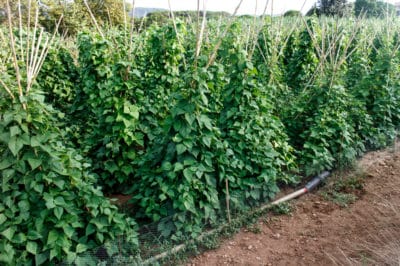Soil for Growing Beans
Beans will generally do well in average garden soil. However, they do need friable soil, as the seeds are relatively large for most varieties and must push large cotyledons (first leaves) through the soil. Soil that is moisture-retentive but also drains well is also necessary for optimum growth. Soil that is poor, sandy or has a high clay content should be amended with organic material to increase humus content.
Soil Nutrients for Beans
The three major nutrients beans need are nitrogen, potassium and phosphorus. However, since they can produce their own nitrogen, it’s important not to add too much, or you’ll have lots of leaves but few flowers and pods. In addition, beans need small amounts of calcium, manganese and iron. Most garden soils contain adequate amounts of these nutrients, although it depends on where you live.
Choosing Bean Varieties
Beans are an ancient vegetable; seeds are easy to save. The 40,000+ varieties include:
- Blue Lake
- Kentucky Wonder
- Roc D’Or
- Gold Marie
- Rattlesnake
- Romano
- Soybeans
- Tepary Beans
- Winged Beans
- Asparagus Beans
Growing Beans Hydroponically
Beans can be grown hydroponically, although pole varieties will take considerable space. If you have limited room, bush varieties may be a better choice. Hydroponic systems can be homemade or commercial. All consist of a container, a medium such as perlite for the plant roots and a nutrient solution. You may also need grow lights if your growing area has limited natural light.
Sprouting Beans
Beans contain all the nutrients they need to germinate and grow a sprout several inches in length. While mung beans are most commonly used for bean sprouts, any bean can be sprouted for culinary use. However, kidney and pinto bean sprouts contain toxins in raw form and should always be cooked. You can sprout beans in a commercial tray, a homemade tray system or a quart glass jar.
Bean Supports
Bush beans have fairly short, stiff stems and need no support. However, pole beans may grow six to 10 feet. They must have something to climb on. Poles made from dowels and saplings, lashed together in a teepee shape, are a classic method. Trellises made from metal fence panels, chain link or wood are also common. Commercial bean towers are also available.
